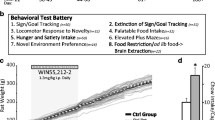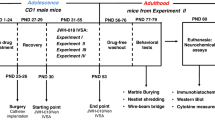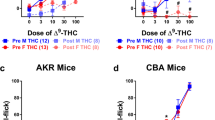Abstract
Rationale
Adolescent cannabinoid exposure has been shown to alter cognitive, reward-related, and motor behaviors as well as mesocorticolimbic dopamine (DA) function in adult animals. Pain is also influenced by mesocorticolimbic DA function, but it is not known whether pain or cannabinoid analgesia in adults is altered by early exposure to cannabinoids.
Objective
To determine whether adolescent Δ9-tetrahydrocannabinol (THC) exposure alters pain-related behaviors before and after induction of persistent inflammatory pain, and whether it influences antinociceptive of THC, in adult rats, and to compare the impact of adolescent THC exposure on pain to its effects on known DA-dependent behaviors such as exploration and consumption of a sweet solution.
Methods
Vehicle or THC (2.5 to 10 mg/kg s.c.) was administered daily to male and female rats on post-natal day (PND) 30–43. In adulthood (PND 80–88), sensitivity to mechanical and thermal stimuli before and after intraplantar injection of complete Freund’s adjuvant (CFA) was determined. Antinociceptive, exploratory, and consummatory effects of 2.0 mg/kg THC were then examined.
Results
Adolescent THC exposure did not significantly alter adult sensitivity to non-noxious or noxious stimuli either before or after CFA injection, nor did it alter the antinociceptive effect of THC. In contrast, adolescent THC exposure altered adult exploratory and consummatory behaviors in a sex-dependent manner: when tested as adults, adolescent THC-treated males showed less hedonic drinking than adolescent vehicle-treated males, and females but not males that had been THC-exposed as adolescents showed reduced sensitivity to THC-induced suppression of activity and THC-induced hedonic drinking as adults.
Conclusions
Adolescent THC exposure that altered both exploratory and consummatory behaviors in adults did not alter pain-related behaviors either before or after induction of inflammatory pain, suggesting that cannabinoid exposure during adolescence is not likely to substantially alter pain or cannabinoid analgesia in adulthood.









Similar content being viewed by others
References
Bainier C, Mateo M, Felder-Schmittbuhl M-P, Mendoza J (2017) Circadian rhythms of hedonic drinking behavior in mice. Neuroscience 349:229–238. https://doi.org/10.1016/j.neuroscience.2017.03.002
Berkley K (1997) Sex differences in pain. Behav Brain Sci 20:371–380. https://doi.org/10.1017/s0140525x97221485
Blanton HL, Barnes RC, McHann MC, Bilbrey JA, Wilkerson JL, Guindon J (2021) Sex differences and the endocannabinoid system in pain. Pharmacol Biochem Behav 202:173107. https://doi.org/10.106/j.pbb.2021.173107
Britch SC, Craft RM (2021) No antinociceptive synergy between morphine and delta-9-tetrahydrocannabinol in male and female rats with persistent inflammatory pain. Behav Pharmacol 32:630–639. https://doi.org/10.1097/FBP.0000000000000657
Britch SC, Goodman AG, Wiley JL, Pondelick AM, Craft RM (2020) Antinociceptive and immune effects of delta-9-tetrahydrocannabinol or cannabidiol in male versus female rats with persistent inflammatory pain. J Pharmacol Exp Ther 373:416–428. https://doi.org/10.1124/jpet.119.263319
Bruijnzeel AW, Knight P, Panunzio S, Xue S, Bruner MM, Wall SC, Pompilus M, Febo M, Setlow B (2019) Effects in rats of adolescent exposure to cannabis smoke or THC on emotional behavior and cognitive function in adulthood. Psychopharmacology 236:2773–2784. https://doi.org/10.1007/s00213-019-05255-7
Burston JJ, Wiley JL, Craig AA, Selley DE, Sim-Selley LJ (2010) Regional enhancement of cannabinoid CB1 receptor desensitization in female adolescent rats following repeated Δ9-tetrahydrocannabinol exposure. Br J Pharmacol 161:103–112. https://doi.org/10.111/j.1476-5381.2010.00870.x
Cohen J (1988) Statistical power analysis for the behavioral sciences. Lawrence Erlbaum Associates, Hillsdale, NJ
Cooper ZD, Craft RM (2017) Sex-dependent effects of cannabis and cannabinoids: A translational perspective. Neuropsychopharmacology Rev. https://doi.org/10.1038/npp.2017.140
Craft RM, Britch SC, Buzitis NW, Clowers BH (2019) Age-related differences in Δ9-tetrahydrocannabinol-induced antinociception in female and male rats. Exp Clin Psychopharm 27:338–347. https://doi.org/10.1037/pha0000257
Cuttler C, Mischley LK, Sexton M (2016) Sex differences in cannabuse use and effects: a cross-sectional survey of cannabis users. Cannabis Cannabinoid Res 1:166–175. https://doi.org/10.1089/can.2016.0010
De Gregorio D, Conway JD, Canul M-L, Posa L, Bambico FR, Gobbi G (2020) Effects of chronic exposure to low-dose delta-9-tetrahydrocannabinol in adolescence and adulthood on serotonin/norepinephrine neurotransmission and emotional behavior. Int J Neuropsychopharm 23:751–761. https://doi.org/10.1093/ipnp/pyaa058
Dow-Edwards D, Frank A, Wade D, Weedon J, Izenwasser S (2016) sexually-dimorphic alterations in cannabinoid receptor density depend upon prenatal/early postnatal history. Neurotoxicol Teratol 58:31–39
Farquhar CE, Breivogel CS, Gamage TF, Gay EA, Thomas BF, Craft RM, Wiley JL (2019) Sex, THC, and hormones: effects on density and sensitivity of CB1 cannabinoid receptors in rats. Drug Alcohol Depend 194:20–27. https://doi.org/10.1016/j.drugalcdep.2018.09.018
Freeman ME (1988) The neuroendocrine control of the ovarian cycle of the rat. In: Knobil E, Neill J (eds) The physiology of reproduction. Raven Press, New York, pp 1893–1928
Gao Y-J, Ren W-H, Zhang Y-Q, Zhao Z-Q (2004) Contributions of the anterior cingulate cortex and amygdala to pain- and fear-conditioned place avoidance in rats. Pain 110:343–353. https://doi.org/10.1016/j.pain.2004.04030
Gibson SJ, Lussier D (2012) Prevalence and relevance of pain in older persons. Pain Med 13:S23–S26. https://doi.org/10.1111/j.1526-4637.2012.01349.x
Grubbs FE (1969) Procedures for detecting outlying observations in samples. Technometrics 11:1–21. https://doi.org/10.1080/00401706.1969.10490657
Han BH, Sherman S, Mauro PM, Martins SS, Rotenberg J, Palamar JJ (2017) Demographic trends among older cannabis users in the United States, 2006–13. Addiction 112:516–525. https://doi.org/10.1111/add.13670
Harte-Hargrove LC, Dow-Edwards DL (2012) Withdrawal from THC during adolescence: sex differences in locomotor activity and anxiety. Behav Brain Res 231:48–59. https://doi.org/10.1016/j.bbr.2012.02.048
Herkenham M, Lynn AB, Johnson MR, Melvin LS, de Costa BR, Rice KC (1991) Characterization and localization of cannabinoid receptors in rat brain: a quantitative in vitro autoradiographic study. J Neurosci 11:563–583
Kandasamy R, Calsbeek JJ, Morgan MM (2017) Analysis of inflammation-induced depression of home cage wheel running in rats reveals the difference between opioid antinociception and restoration of function. Behav Brain Res 317:502–507. https://doi.org/10.1016/j.bbr.2016.10.024
Kaskie B, Ayyagari P, Milavetz G, Shane D, Arora K (2017) The increasing use of cannabis among older Americans: a public health crisis or viable policy alternative? Gerontologist 57:1166–1172. https://doi.org/10.1093/geront/gnw166
Krebs M-O, Kebir O, Jay TM (2019) Exposure to cannabinoids can lead to persistent cognitive and psychiatric disorders. Eur J Pain. https://doi.org/10.1002/ejp.1377
Kruse LC, Cao JK, Viray K, Stella N, Clark JJ (2019) Voluntary oral consumption of Δ9-tetrahydrocannabinol by adolescent rats impairs reward-predictive cue behaviors in adulthood. Neuropsychopharmacology 44:1406–1414. https://doi.org/10.1038/s41386-019-0387-7
Mansfield KE, Sim J, Jordan JL, Jordan KP (2016) A systematic review and meta-analysis of the prevalence of chronic widespread pain in the general population. Pain 157:55–64. https://doi.org/10.1097/j.pain.00000000000000314
Melis M, De Felice M, Lecca S, Fattore L, Pistis M (2013) Sex-specific tonic 2-arachidonoylglycerol signaling at inhibitory inputs onto dopamine neurons of Lister Hooded rats. Front Integr Neurosci 7:1–13. https://doi.org/10.3389/fnint.2013.00093
Meder D, Herz DM, Rowe JB, Lehericy S, Sibner HR (2019) The role of dopamine in the brain – lessons learned from Parkinson’s disease. Neuroimage 190:79–93. https://doi.org/10.1016/j.neuroimage.2018.11.021
Meyer HC, Lee FS, Gee DG (2018) The role of the endocannabinoid system and genetic variation in adolescent brain development. Neuropsychopharm Rev 43:21–33. https://doi.org/10.1038/npp.2017.143
Mogil JS (2020) Qualitative sex differences in pain processing: emerging evidence of a biased literature. Nature Rev Neurosci. https://doi.org/10.1038/s41583-020-0310-6
National Research Council (2011) Guide for the care and use of laboratory animals. National Academies Press, Washington DC
Nguyen JD, Creehan KM, Kerr TM, Taffe MA (2020) Lasting effects of repeated Δ9-tetrahydrocannabinol vapour inhalation during adolescence in male and female rats. Br J Pharmacol 177:188–203. https://doi.org/10.1111/bph.14856
Ong W-Y, Stohler CS, Herr DR (2019) Role of the prefrontal cortex in pain processing. Mol Neurobiol 56:1137–1166. https://doi.org/10.1007/s12035-018-1130-9
Parsons LH, Hurd YL (2015) Endocannabinoid signaling in reward and addiction. Nat Rev Neurosci 16:579–594. https://doi.org/10.2018/nrn4004
Poulia N, Delis F, Brakatselos C, Lekkas P, Kokras N, Dalla C, Antoniou K (2019) Escalating low-dose Δ9-tetrahydrocannabinol exposure during adolescence induces differential behavioral and neurochemical effects in male and female rats. Eur J Neurosci. https://doi.org/10.1111/ejn.14598
Poulia N, Delis F, Brakatselos C, Polissidis A, Koutmani Y, Kokras N, Dalla C, Politis PK, Antoniou K (2021) Detrimental effects of adolescent escalating low-dose Δ9-tetrahydrocannabinol leads to a specific bio-behavioural profile in adult male rats. Br J Pharmacol 178:1722–1736. https://doi.org/10.1111/bph.15394
Pushkin AN, Eugene AJ, Lallai V, Torres-Mendoza A, Fowler JP, Chen E, Fowler CD (2019) Cannabinoid and nicotine exposure during adolescence induces sex-specific effects on anxiety- and reward-related behaviors during adulthood. PLoS ONE. https://doi.org/10.1371/journal.pone.0211346
Reinarman C, Nunberg H, Lanthier F, Heddleston T (2011) Who are medical marijuana patients? Population characteristics from nine California assessment clinics. J Psychoactive Drugs 43:128–135. https://doi.org/10.1080/02791072.2011.587700
Renard J, Rosen LG, Loureiro M, De Oliveira C, Schmid S, Rushlow WJ, Laviolette SR (2017) Adolescent cannabinoid exposure induces a persistent sub-cortical hyper-dopaminergic state and associated molecular adaptations in the prefrontal cortex. Cereb Cortex 27:1297–1310. https://doi.org/10.1093/cercor/bhv335
Rubino T, Vigano D, Realini N, Guidali C, Braida D, Capurro V, Castiglioni C, Cherubino F, Romualdi P, Candeletti S, Sala M, Parolaro D (2008) Chronic Δ9-tetrahydrocannabinol during adolescence provokes sex-dependent changes in the emotional profile in adult rats: behavioral and biochemical correlates. Neuropsychopharmacology 33:2760–2771. https://doi.org/10.1038/sj/npp.1301664
Ruiz CM, Torrens A, Castillo E, Perrone CR, Cevallos J, Inshishian VC, Harder EV et al (2020) Pharmacokinetic, behavioral, and brain activity effects of Δ9-tetrahydrocannabinol in adolescent male and female rats. Neuropsychopharmacology. https://doi.org/10.1038/s41386-020-00839-w
Scherma M, Dessi C, Muntoni AL, Lecca S, Satta V, Luchicchi A, Pistis M, Panlilio LV, Fattore L, Goldberg SR, Gratta W, Fadda P (2016) Adolescent Δ9-tetrahydrocannabinol exposure alters WIN55,212–2 self-administration in adult rats. Neuropsychopharmacology 41:1416–1426. https://doi.org/10.1038/npp.2015.295
Schneider LH (1989) Orosensory self-stimulation by sucrose involves brain dopaminergic mechanisms. Ann N Y Acad Sci 575:307–319. https://doi.org/10.1111/j.1749-6632.1989.tb53252.x
Schoch H, Huerta MY, Ruiz CM, Farrell MR, Jung KM, Huang JJ, Campbell RR, Piomelli D, Mahler SV (2018) Adolescent cannabinoid exposure effects on natural reward seeking and learning in rats. Psychopharmacology 235:121–134. https://doi.org/10.1007/s00213-017-4749-8
Silva L, Black R, Michaelides M, Hurd YL, Dow-Edwards D (2016) Sex and age specific effects of delta-9-tetrahydrocannabinol during the periadolescent period in the rat: The unique susceptibility of the prepubescent animal. Neurotoxicol Teratol 58:88–100. https://doi.org/10.1016/j.ntt.2016.02.005
Sorge RE, Totsch SK (2017) Sex differences in pain. J Neurosci Res 95:1271–1281. https://doi.org/10.1002/jnr.23841
Spear LP (2000) The adolescent brain and age-related behavioral manifestations. Neurosci Biobehav Rev 24:417–463
Stringfield SS, Torregrossa MM (2021) Disentangling the lasting effects of adolescent cannabinoid exposure. Prog Neuropsychopharm Biol Psychiat 104:110067. https://doi.org/10.1016/j.pnpbp.2020.110067
Tagne AM, Fotio Y, Rashid TI, Piomelli D (2021) Persistent exposure to Δ9-tetrahydrocannabinol during adolescence does not affect nociceptive responding in adult mice. J Pharmacol Exp Ther. https://doi.org/10.1124/jpet.121.000740
Thompson JM, Neugebauer V (2019) Cortico-limbic pain mechanisms. Neurosci Lett 702:15–23. https://doi.org/10.1016/j.neulet.2018.11.037
Tirado-Muñoz J, Lopez-Rodriguez AB, Fonseca F, Farré M, Torrens M, Viveros M-P (2020) Effects of cannabis exposure in the prenatal and adolescent periods: preclinical and clinical studies in both sexes. Front Neuroendocrinol 57:100841. https://doi.org/10.1016/j.yfrne.2020.100841
Tõnissaar M, Herm L, Rinken A, Harro J (2006) Individual differences in sucrose intake and preference in the rat: Circadian variation and association with dopamine D2 receptor function in striatum and nucleus accumbens. Neurosci Lett 403:119–124. https://doi.org/10.1016/j.neulet.2006.04.023
Unruh A (1996) Gender variations in clinical pain experience. Pain 65:123–167. https://doi.org/10.1016/0304-3959(95)00214-6
Vetter-O’Hagen CS, Spear LP (2012) Hormonal and physical markers of puberty and their relationship to adolescent-typical novelty-directed behavior. Dev Psychobiol 54:523–535. https://doi.org/10.1002/dev.20610
Wakley AA, Wiley JL, Craft RM (2014) Sex differences in antinociceptive tolerance to delta-9-tetrahydrocannabinol in the rat. Drug Alc Depend 413:22–28. https://doi.org/10.1016/j.drugalcdep.2014.07.029
Wiley JL, Burston JJ (2014) Sex differences in Δ9-tetrahydrocannabinol metabolism and in vivo pharmacology following acute and repeated dosing in adolescent rats. Neurosci Lett 576:51–55. https://doi.org/10.1016/j.neulet.2014.05.057
Wiley JL, Barrus DG, Farquhar CE, Lefever TW, Gamage TF (2021) Sex, species and age: Effects of rodent demographics on the pharmacology of Δ9-tetrahydrocannabinol. Prog Neuropsychopharm Biol Psychiatry 106:110064. https://doi.org/10.1016/j.pnpbp.2020.110064
Wilson-Poe AR, Wiese B, Kibaly C, Lueptow L, Garcia J, Anand P, Cahill C, Morón JA (2021) Effects of inflammatory pain on CB1 receptor in the midbrain periaqueductal gray. Pain Reports 6:e897. https://doi.org/10.1097/PR9.0000000000000897
Ziółkowska B (2021) The role of the mesostriatal dopamine system and corticostriatal glutamatergic transmission in chronic pain. Brain Sci 11:1311. https://doi.org/10.3390/brainsci11101311
Acknowledgements
The authors thank I. McCaughran for technical assistance.
Funding
This research was supported by a Herbert L. Eastlick Professorship from the College of Arts and Sciences at Washington State University (to R.C.).
Author information
Authors and Affiliations
Corresponding author
Ethics declarations
Conflict of interest
The authors declare no competing interests.
Additional information
Publisher's note
Springer Nature remains neutral with regard to jurisdictional claims in published maps and institutional affiliations.
This article belongs to a Special Issue on Cannabis and Cannabinoids
Rights and permissions
About this article
Cite this article
Gogulski, H.Y., Craft, R.M. Adolescent THC exposure: effects on pain-related, exploratory, and consummatory behaviors in adult male vs. female rats. Psychopharmacology 239, 1563–1578 (2022). https://doi.org/10.1007/s00213-022-06094-9
Received:
Accepted:
Published:
Issue Date:
DOI: https://doi.org/10.1007/s00213-022-06094-9




